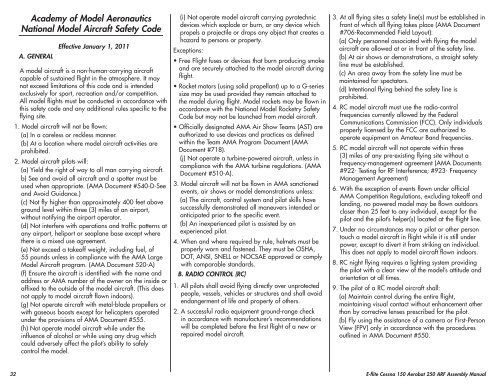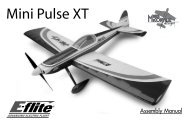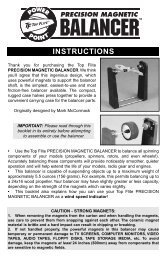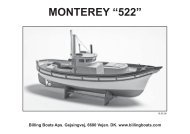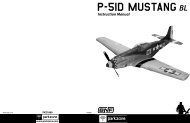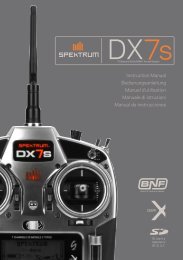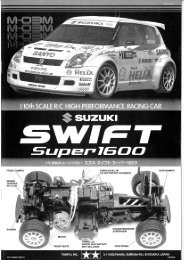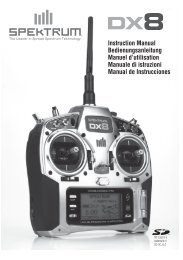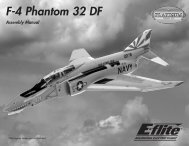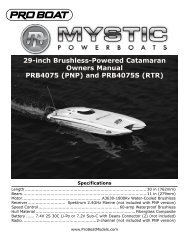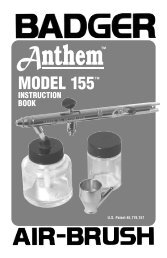Cessna 150 Aerobat 250 ARF - Great Hobbies
Cessna 150 Aerobat 250 ARF - Great Hobbies
Cessna 150 Aerobat 250 ARF - Great Hobbies
- No tags were found...
You also want an ePaper? Increase the reach of your titles
YUMPU automatically turns print PDFs into web optimized ePapers that Google loves.
Academy of Model AeronauticsNational Model Aircraft Safety CodeA. GENERALEffective January 1, 2011A model aircraft is a non-human-carrying aircraftcapable of sustained flight in the atmosphere. It maynot exceed limitations of this code and is intendedexclusively for sport, recreation and/or competition.All model flights must be conducted in accordance withthis safety code and any additional rules specific to theflying site.1. Model aircraft will not be flown:(a) In a careless or reckless manner.(b) At a location where model aircraft activities areprohibited.2. Model aircraft pilots will:(a) Yield the right of way to all man carrying aircraft.b) See and avoid all aircraft and a spotter must beused when appropriate. (AMA Document #540-D-Seeand Avoid Guidance.)(c) Not fly higher than approximately 400 feet aboveground level within three (3) miles of an airport,without notifying the airport operator.(d) Not interfere with operations and traffic patterns atany airport, heliport or seaplane base except wherethere is a mixed use agreement.(e) Not exceed a takeoff weight, including fuel, of55 pounds unless in compliance with the AMA LargeModel Aircraft program. (AMA Document 520-A)(f) Ensure the aircraft is identified with the name andaddress or AMA number of the owner on the inside oraffixed to the outside of the model aircraft. (This doesnot apply to model aircraft flown indoors).(g) Not operate aircraft with metal-blade propellers orwith gaseous boosts except for helicopters operatedunder the provisions of AMA Document #555.(h) Not operate model aircraft while under theinfluence of alcohol or while using any drug whichcould adversely affect the pilot’s ability to safelycontrol the model.(i) Not operate model aircraft carrying pyrotechnicdevices which explode or burn, or any device whichpropels a projectile or drops any object that creates ahazard to persons or property.Exceptions:• Free Flight fuses or devices that burn producing smokeand are securely attached to the model aircraft duringflight.• Rocket motors (using solid propellant) up to a G-seriessize may be used provided they remain attached tothe model during flight. Model rockets may be flown inaccordance with the National Model Rocketry SafetyCode but may not be launched from model aircraft.• Officially designated AMA Air Show Teams (AST) areauthorized to use devices and practices as definedwithin the Team AMA Program Document (AMADocument #718).(j) Not operate a turbine-powered aircraft, unless incompliance with the AMA turbine regulations. (AMADocument #510-A).3. Model aircraft will not be flown in AMA sanctionedevents, air shows or model demonstrations unless:(a) The aircraft, control system and pilot skills havesuccessfully demonstrated all maneuvers intended oranticipated prior to the specific event.(b) An inexperienced pilot is assisted by anexperienced pilot.4. When and where required by rule, helmets must beproperly worn and fastened. They must be OSHA,DOT, ANSI, SNELL or NOCSAE approved or complywith comparable standards.B. RADIO CONTROL (RC)1. All pilots shall avoid flying directly over unprotectedpeople, vessels, vehicles or structures and shall avoidendangerment of life and property of others.2. A successful radio equipment ground-range checkin accordance with manufacturer’s recommendationswill be completed before the first flight of a new orrepaired model aircraft.3. At all flying sites a safety line(s) must be established infront of which all flying takes place (AMA Document#706-Recommended Field Layout):(a) Only personnel associated with flying the modelaircraft are allowed at or in front of the safety line.(b) At air shows or demonstrations, a straight safetyline must be established.(c) An area away from the safety line must bemaintained for spectators.(d) Intentional flying behind the safety line isprohibited.4. RC model aircraft must use the radio-controlfrequencies currently allowed by the FederalCommunications Commission (FCC). Only individualsproperly licensed by the FCC are authorized tooperate equipment on Amateur Band frequencies.5. RC model aircraft will not operate within three(3) miles of any pre-existing flying site without afrequency-management agreement (AMA Documents#922- Testing for RF Interference; #923- FrequencyManagement Agreement)6. With the exception of events flown under officialAMA Competition Regulations, excluding takeoff andlanding, no powered model may be flown outdoorscloser than 25 feet to any individual, except for thepilot and the pilot’s helper(s) located at the flight line.7. Under no circumstances may a pilot or other persontouch a model aircraft in flight while it is still underpower, except to divert it from striking an individual.This does not apply to model aircraft flown indoors.8. RC night flying requires a lighting system providingthe pilot with a clear view of the model’s attitude andorientation at all times.9. The pilot of a RC model aircraft shall:(a) Maintain control during the entire flight,maintaining visual contact without enhancement otherthan by corrective lenses prescribed for the pilot.(b) Fly using the assistance of a camera or First-PersonView (FPV) only in accordance with the proceduresoutlined in AMA Document #550.32 E-flite <strong>Cessna</strong> <strong>150</strong> <strong>Aerobat</strong> <strong>250</strong> <strong>ARF</strong> Assembly Manual


